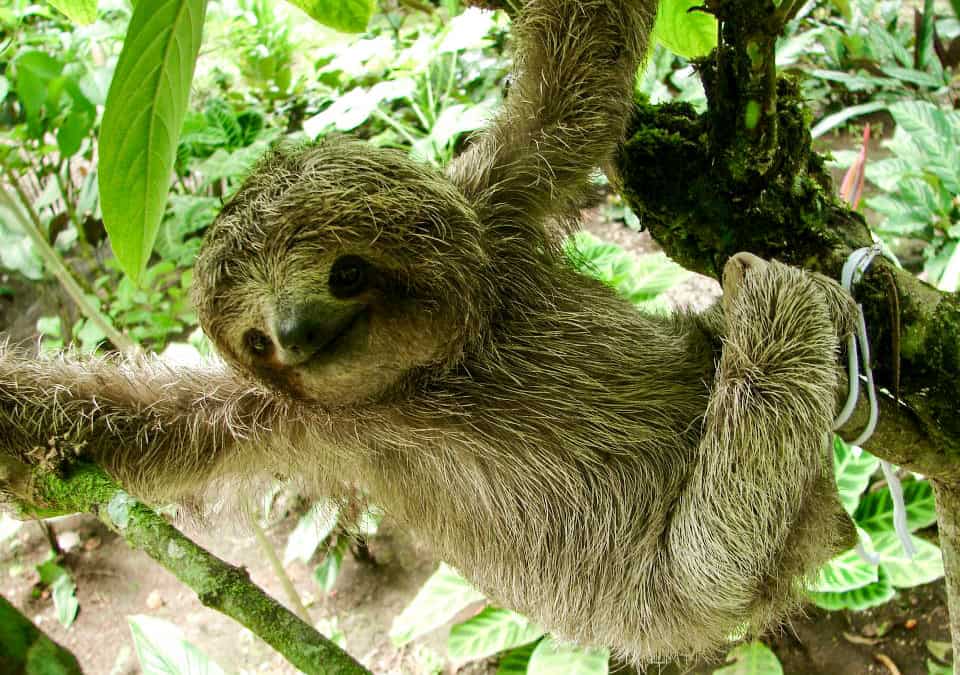When thinking about Costa Rica two main animals will come to mind often: sloths and the red-eyed frog. Today we will be talking about the cutest of the two: the sloth. Stay with us and learn more about this smiley friend and where to find Sloths in Costa Rica.
General information about Sloths
The sloths have inhabited our planet Earth for over 60 million years. Even though they look like monkeys or bears, the sloths belong to the superorder Xenarthra, which also includes anteaters and armadillos. At the same time, the order of Pilosa ties up the sloths and anteaters due to their “hairy” look. And finally, the suborder Folivora groups the different species of sloths into two remaining families:
1.The three-toed sloth with four species of which the brown-throated sloth inhabits Costa Rica.

Brown-throated sloth. Image courtesy of Backcountry Journeys
2.The Megalonychidae, which contains the two-toed sloth genus, that at the same time includes the Hoffmann’s two-toed sloth that can be found in our country.

Hoffmann’s two-toed sloth. Image courtesy of Kids NatGeo.
So regularly, you will hear about two- or three-toed sloths, however that would be the name of the family not actually the name of the species. And, even though the two families belong to the Folivora group, there is no evidence of a last shared common ancestor.
The arboreal mammals can only be found in Central and South America.
The two families of sloths share their taste for eating tree leaves, however each one has a specific diet. While the two-toed sloth also includes insects, fruits and small lizards and moves in large areas of the forest; the three-toed sloth only likes the leaves of a limited number of trees, and it is normal for its activity to be limited to small areas.
A sloth can get to measure up to 2.5 feet, and weight up to 17 lb, being the two-toed larger than the three-toed. Sloths live most of their time up in the tree canopy. Three-toed sloths descend just once a week to excrete.
Sloths move so slow due to their extremely low metabolism, lasting up to a week to digest. It also is an evolutionary adaptation, so they could be less noticeable to potential predators.
The sloths are an ecosystem of its own, hosting colonies of algae, fungi, moths, mites, and other arthropods. The algae give a greenish color to its fur, allowing them to camouflage.
Interesting facts
- Three-toed sloths can rotate its head through 270°
- The hair of the sloth grows in opposite direction than the rest of the mammals. This because of the time they spend with their limbs above the rest of their body.
- Sloths sleep, eat and give birth hanging from tree branches. Occasionally they even remain hanging after death.
- Sloths move at a speed of 13 ft per minute, being able to move 0,02 miles per day.
- Sloths can´t walk, so they drag themselves on the ground. However, three-toed sloths make great swimmers being able
- Sloths are able to reduce even more their slow metabolism and slow their heart rate.
- Ancient sloths were larger, being the Megatherium eve larger than an elephant.
- Two-toed sloths are wrongly named as all families of sloths have three-toes. The difference lays on their fingers, so the correct name should be two-fingered sloths.
- Two-toed sloths are nocturnal while three-toed sloths are diurnal
- It is thought that sloths sleep more than 15 hours per day, however this only happens in captivity. In wildlife, sloths sleep the same amount of time than humans.
- The lifespan of a sloth varies from one species to the other, but on average they live from 20 to 30 years in the wild and longer in captivity.
- Sloths have low muscle mass, representing just 25 to 30% of their body weight.
- Sloths don’t shiver, regulating their temperature with the environment, taking sunbaths or shading.
- Two-toed sloths prefer to descend with the head first.
- Sloths are solitary creatures.
- Gestation periods for sloths vary from one species to the other. For the three-toed, the period last 6 months; for the two-toed it could go from 6 to 12 months. Three-toed babies are weaned around nine-months of age, while the two-toed only after a month.
- Thanks to the coloring of their faces, three-toed sloths seem to be smiling all the time with a Pura Vida attitude.
- A sloth was the star of one of the country´s marketing campaigns called: Save the Americans.
Where to find sloths in Costa Rica?
You will find a slot wherever there is a rainforest. However, no matter where you go, an untrained eye will find impossible to spot a sloth within the branches and leaves of the lush forest. We recommend you to always travel with a certifies guide to enhance your experience and have more probabilities of watching a slot in the wild.
Some areas you can visit for sloth watching in the wild include:
- The north side of the Rincon de la Vieja volcano
- The Arenal Volcano National Park and its surroundings
- The Caribbean coast of Costa Rica including the Gandoca-Manzanillo Wildlife Refuge and the Cahuita National Park
- The South Pacific Coast including the Manuel Antonio National Park, the Corcovado National Park, and the La Amistad International Park.
If you prefer a more controlled environment you can visit the following associations dedicated to protecting our “Pura Vida” fellow:
Costa Rica is home to 500,000 species, among all of them it is impossible to deny that Sloths have a special place. Sloths are not only cute but also represent the mystery of evolution and the beauty of mother earth.
On your next visit to Costa Rica be sure not to miss the experience of being close to one of these amazing animals. Contact us and we will be sure to help you achieve it!

